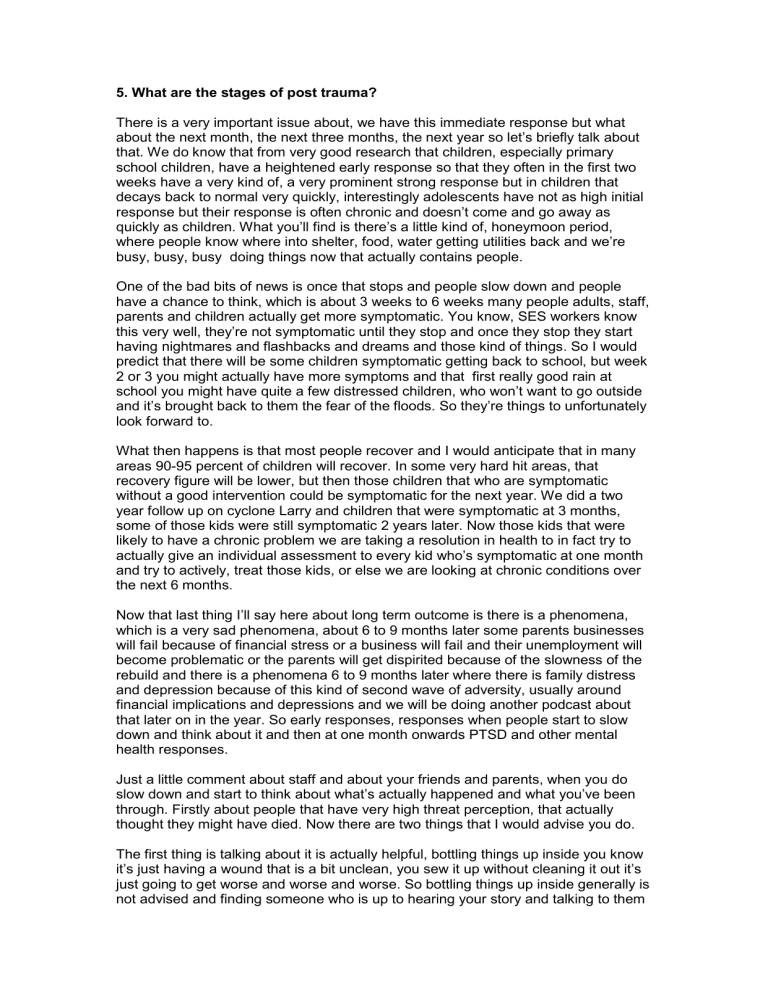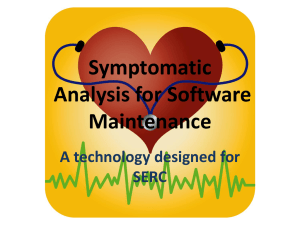View stages of post trauma transcript (DOC version)

5. What are the stages of post trauma?
There is a very important issue about, we have this immediate response but what about the next month, the next three months, the next year so let’s briefly talk about that. We do know that from very good research that children, especially primary school children, have a heightened early response so that they often in the first two weeks have a very kind of, a very prominent strong response but in children that decays back to normal very quickly, interestingly adolescents have not as high initial response but their response is often chronic and doesn’t come and go away as quickly as children. What you’ll find is there’s a little kind of, honeymoon period, where people know where into shelter, food, water getting utiliti es back and we’re busy, busy, busy doing things now that actually contains people.
One of the bad bits of news is once that stops and people slow down and people have a chance to think, which is about 3 weeks to 6 weeks many people adults, staff, parents and children actually get more symptomatic. You know, SES workers know this very well, they’re not symptomatic until they stop and once they stop they start having nightmares and flashbacks and dreams and those kind of things. So I would predict that there will be some children symptomatic getting back to school, but week
2 or 3 you might actually have more symptoms and that first really good rain at school you might have quite a few distressed children, who won’t want to go outside and it’s brought back to them the fear of the floods. So they’re things to unfortunately look forward to.
What then happens is that most people recover and I would anticipate that in many areas 90-95 percent of children will recover. In some very hard hit areas, that recovery figure will be lower, but then those children that who are symptomatic without a good intervention could be symptomatic for the next year. We did a two year follow up on cyclone Larry and children that were symptomatic at 3 months, some of those kids were still symptomatic 2 years later. Now those kids that were likely to have a chronic problem we are taking a resolution in health to in fact try to actually give an individual assessment to every kid who’s symptomatic at one month and try to actively, treat those kids, or else we are looking at chronic conditions over the next 6 months.
Now that last thing I’ll say here about long term outcome is there is a phenomena, which is a very sad phenomena, about 6 to 9 months later some parents businesses will fail because of financial stress or a business will fail and their unemployment will become problematic or the parents will get dispirited because of the slowness of the rebuild and there is a phenomena 6 to 9 months later where there is family distress and depression because of this kind of second wave of adversity, usually around financial implications and depressions and we will be doing another podcast about that later on in the year. So early responses, responses when people start to slow down and think about it and then at one month onwards PTSD and other mental health responses.
Just a little comment about staff and about your friends and parents, when you do slow down and start to think about what’s actually happened and what you’ve been through. Firstly about people that have very high threat perception, that actually thought they might have died. Now there are two things that I would advise you do.
The first thing is talking about it is actually helpful, bottling things up inside you know it’s just having a wound that is a bit unclean, you sew it up without cleaning it out it’s just going to get worse and worse and worse. So bottling things up inside generally is not advised and finding someone who is up to hearing your story and talking to them
and getting support, staying very connected with friends and using them as support and talking about it is actually very helpful. And don’t forget that there are different ways of talking about it, one way of talking about it is writing in a diary, writing in a journal, but also, talking to friends about it. You need to sort of be a bit selective, you can’t obviously talk to other highly traumatised people and just upset each other, that’s actually not helpful, but talking about what you went through can be very cathartic and very helpful.
Another tip is that a lot of people have phobic avoidance, which means that they never face the fears in terms of places where they were scared and places where they became very frightened. At the end of the day the bad news is that if you don’t go back to those places, you might never go back to those places and with a support person, with a loved done or someone who is not as traumatised actually going back we find kids, for instance an example after the Brisbane storms, kids were very frightened in the storms were playing netball never went back to play netball. Now that’s a tragedy, you know but with help they could get back and doing it again. So people need to go back and face those fears and to do it in a socially connected way is actually very powerful.
Now one other bit of advices is, if you can’t do that, if you can’t face that, thinking about those things and talking about it or going to the place, this is a very good indication that you might need some help.
It’s a lovely little experiment, if you can not go back to that crossing where you were very scarred or t hat place where you thought you’d be swept away, if you can’t face to go back there or face those thoughts, you might need to go and see your GP and talk about that, or go and see a psychologist through the ATAPS process or go and see a mental health counsellor , it’s a lovely little experiment that you can do to asses how yo u’re travelling.








